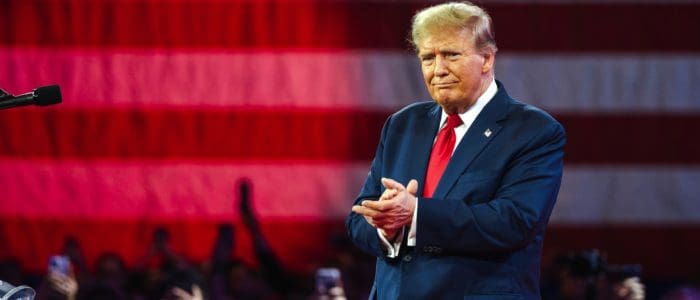Published
Buckle Up – A Second Trump Administration and Europe
By: Fredrik Erixon
Subjects: European Union North-America

It must be the most remarkable comeback ever in democratic political history, but Donald Trump has won the Presidential election and will in January next year return to the White House. The whole cottage industry of observers and analysts will be spending the next couple of months understanding what this means for US policy and global developments. While the world has a better understanding of the Trump style of policy now – compared to his shock victory in 2016 when everyone was flying in the dark – the truth is that few analysts have a deeper understanding of what goes in Trump world. After his last victory, he was surrounded in cabinet by people of experience and that worked with traditional political methods – people like Mike Pence, Jim Mattis, H.R. McMaster, and Steve Mnuchin. It is less clear that Trump’s next administration will include such leaders who can control the impulsive, illiberal, and headline-seeking character of the President, and the chaotic and irate MAGA-types that all too often is intimate with political madness. In short, the course of the next administration is unpredictable: we should be prepared for turbulence.
Europe may be fearing the return of Trump more than many other geographies. There is a war in Ukraine and, in the past two and a half years, Ukraine’s resistance and combat power would be unthinkable without the support of the United States. Trump’s dismissive attitude to Ukraine’s war effort and American support, and his constant sneering of Western alliances and partnerships, makes the European security situation much, much, much more troubling.
Europe remains incapable to defend itself and just don’t have the resources necessary for exacerbated geopolitical conflicts on its Eastern border. Russia and opportunists are fully capable of exploiting Europe’s weaknesses, and with weak political leadership in Berlin, Brussels, and Paris there will likely be new opportunities for Moscow to take actions without the risk of impunity. Obviously, uncertainties about what role that a Trump administration would play in the region are Europe’s greatest problem with a second Trump administration.
But the election of Trump will also put light on other issues that Europe are struggling with. Here are some other themes that will be important to observe.
- Trade. It’s clear that the new Trump administration will reinforce its protectionism and economic security measures against China. The US will prompt Europe to follow its path – a development that already has caused political friction and adverse business consequences in the EU. But even if Europe stick to its current position – a halfway house of openness and restrictions – the region will feel the effects of US disengagement with the Middle Kingdom. Then there is direct trade confrontation between the US and the EU, and the risks of further de-escalation of the Transatlantic economic compact are very high.
- Tech. The new Trump administration won’t have the same bandwidth with the EU’s digital regulations and its hounding of US tech firms as the Biden administration. Trump is likely to take a laissez faire attitude to domestic tech regulations and change the direction of competition and regulatory policy at the Federal Trade Commission and the US Department of Justice. Trump may go hard after some big tech companies and force them to break up, but this would be more targeted actions than seeking to develop a broader regulatory approach. Frictions with Europe are obvious, and may now be exacerbated by calls by some to take remedial actions against Europe for its digital restrictions and general defensive stance on digital openness. A new US administration may start to explore restrictions that could drastically hurt the European economy and business competitiveness.
- Deregulation. Trump has already a semi-anointed deregulation czar in Elon Musk. It may that much will not come out of that association, but it is likely that a new Trump administration will put forward a deregulation agenda that puts Europe in a difficult spot. Europe’s own bonanza of regulations in the last five years have created significant competitive disadvantages for firms in Europe – and the gap in burdens and costs between the two regions can go up significantly. A cut in funding for industrial support (under the Inflation Reduction Act) may make the situation better for some EU firms who have been competing with US firms getting subsidies, but the energy cost differential can structurally widen again. And further US reforms of corporate taxes will exacerbate European tax disadvantages. Such a development will be awkward for a Europe that remains committed to an agenda of higher regulation and regulatory burdens.
- Climate. While some in Europe have complained about the Biden administration’s commitment to reducing carbon emissions, there was a broad meeting of minds between the administration and the EU’s approach. This intimacy also covered the designs of policies – including policies to increase the cost of energy and reducing the space for new industrial projects. The first Trump administration took a different attitude and the new Trump administration is likely to be closer to Trump I rather than the Biden administration. This will create broad political frictions in climate policy, and with the EU Carbon Border Adjustment Mechanism getting operational soon there will also be big trade frictions emerging from diverging approaches to climate change policy.
There are other areas too that could become subject to Transatlantic friction. There are also areas where there are remaining unity between the two sides. But Europe now needs to take actions to prepare itself for a different development than in the past years – first and foremost to improve its geopolitical capabilities and raise its own long-term competitiveness. It is going to be a turbulent period for Europe. Buckle up!